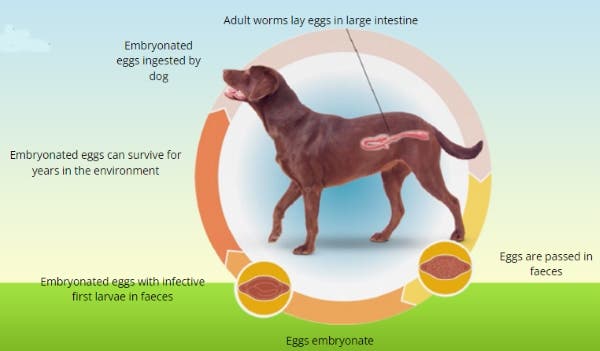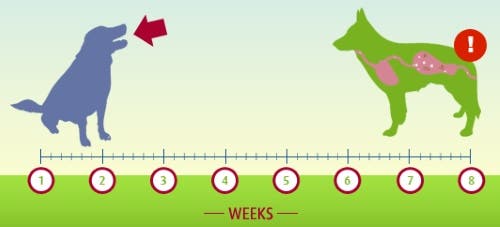What are whipworms in pets?
Whipworms - specifically the species Trichuris vulpis - are intestinal parasites that can affect dogs in the UK but rarely cats. Whipworms are relatively rare in the UK, and tend to be found where large numbers of dogs cohabitate, such as a kennels, because it takes a large amount of eggs to cause an infection; whipworm eggs can be found in the faeces of infected dogs and caught if other dogs then swallow them.

Whipworms Factoid!
The name whipworm refers to the shape of the worm; they look like whips with wider ‘handles’ at the posterior end and feed on their blood.
Animals at risk of whipworms include:

The symptoms of whipworms
If low numbers of worms are present dogs may not show symptoms, but in heavy infestations the worms cause damage to the intestines through feeding and with their whip like tails which can lead to diarrhoea containing blood.

Lifecycle and stages of whipworms

Infection stages: It can take about 8 weeks from the time of ingesting the parasite eggs to the time the dog starts shedding eggs in their faeces.

Risks of whipworms to humans
Fortunately, whipworm is one parasite humans can't pick up.
Spread of whipworms in Europe
Although relatively rare in the UK, whipworm is more prevalent in Europe especially the warmer south so do talk to your vet if you plan to travel with your dog.

How to get rid of whipworms in pets
If you are concerned about whipworm infection in your dog (for example if you are travelling or if your dog is staying in kennels or with large groups of other dogs) then speak with your vet about which wormer is best to use for your dog and how often you should use it.
Find out more about other worms in pets
This information was provided to you by Elanco Animal Health makers of Milbemax™.
Information regarding the side effects, precautions, warnings and contra-indications can be found in product packaging and leaflets; further information can also be found in the Summary of Product Characteristics. Use medicines responsibly (UK). Advice should be sought from the prescriber prior to use. Prescription decisions are for the person issuing the prescription alone.
Milbemax™, Elanco™ and the diagonal bar logo are trademarks of Elanco or its affiliates.
